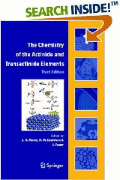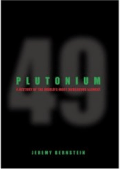|
|
|
|
Information about this site:
|
|
|
The author- or copyrights of
the listed Internet pages are held by
the respective authors or site
operators, who are also responsible for
the content of the presentations.
|
|
|
To include your website to the
Internetchemistry directory, please use
our
registration form or
send us an
eMail. |
Citation: |
www.internetchemistry.com/chemical-elements/plutonium.htm |
Entries: |
32 |
Topic: |
Plutonium, Pu, Element 94 |
Keywords: |
Chemistry, physics, properties, data, chemical, element, actinides, compounds, reactions, Plutonium, Pu |
Update: |
19.05.2013 00:00:00 [link check] |
|
19.05.2013 [site update] |
Chemistry information
not found? Try this form: |
|
|
|
Related Books and Scientific Literature: Plutonium:
|
|

|
L.R. Morss, Norman M. Edelstein, Jean Fuger, Joseph J. Katz
The Chemistry of the Actinide and Transactinide Elements
The Chemistry of the Actinide and Transactinide Elements is the contemporary and definitive exposition of chemical properties of all of the actinide elements, especially of the technologically important elements uranium and plutonium, as well as the transactinide elements. In addition to the comprehensive treatment of the chemical properties of each element, ions and compounds from atomic number 89 (actinium) through 109 (meitnerium), the multi-volume work has specialized and authoritative chapters on electronic theory, optical and laser fluorescence spectroscopy, X-ray absorption spectroscopy, organoactinide chemistry, thermodynamics, magnetic properties, the metals, coordination chemistry, separations, trace analysis. The fourth edition of "The Chemistry of the Actinide and Transactinide Elements" comprises all chapters in volumes 1 through 5 of the third edition (published in 2006) plus a new volume 6. To remain consistent with the plan of the first edition, “ … to provide a comprehensive and uniform treatment of the chemistry of the actinide [and transactinide] elements for both the nuclear technologist and the inorganic and physical chemist,” and to be consistent with the maturity of the field, the fourth edition is organized in three parts.
Springer; 2011
|
|

|
Jeremy Bernstein
Plutonium
A History of the World's Most Dangerous Element
When plutonium was first manufactured at Berkeley in the spring of 1941, there was so little of it that it was not visible to the naked eye. It took a year to accumulate enough so that one could actually see it. Now there is so much of it that we do not know what to do to get rid of it. We have created a monster. The history of plutonium is as strange as the element itself. When scientists began looking for it, they did so simply in the spirit of inquiry, not certain whether there were still spots to fill on the periodic table. But the discovery of fission made it clear that this still-hypothetical element would be more than just a scientific curiosity - it could be a powerful nuclear weapon. As it turned out, it is good for almost nothing else. Plutonium's nuclear potential put it at the heart of the World War II arms race - the Russians found out about it through espionage, the Germans through independent research. Everybody wanted some. Now, nearly everyone has some - the United States alone has about 47 metric tons - but it has almost no uses besides warmongering. How did the product of scientific curiosity become such a dangerous burden? In his new history of this complex and dangerous element, noted physicist Jeremy Bernstein describes the steps that were taken to transform plutonium from a laboratory novelty into the nuclear weapon that destroyed Nagasaki. This is the first book to weave together the many strands of plutonium's story, explaining not only the science but the people involved.
Joseph Henry Press; 2007
|
Internetchemistry ChemLin © 1996
- 2013 A. J.
|



